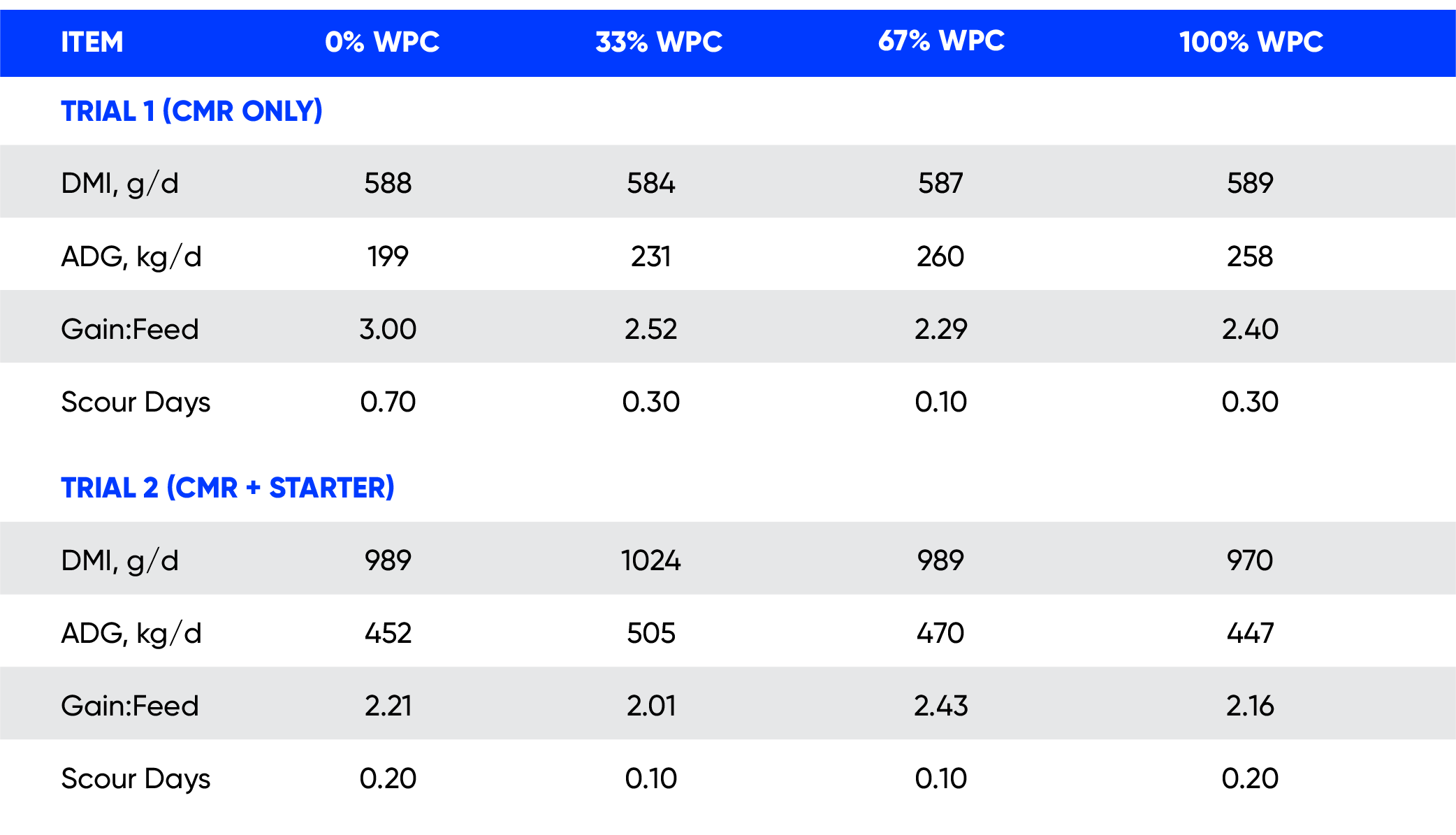Impact of Milk Protein Source on Nutrient Digestibility & Calf Performance
Defining the nutritional and functional differences between skim milk powder and whey protein concentrate and exploring the effects of these milk protein sources on nutrient digestibility and performance in calves.

Calf milk replacer (CMR) is fed to a majority of the dairy calves in the United States in place of whole milk because it is often more economical, provides convenience and consistency, and lowers risk of disease transmission from unpasteurized milk. Many CMRs are made exclusively from dairy ingredients due to the calf’s innate ability to efficiently digest, absorb, and utilize the nutrients that naturally exist in ingredients of dairy origin.
Research into products to replace whole milk began in the mid-20th century and primarily utilized casein, skim milk, and whey as protein sources. As reviewed in Kertz et al. (2017), the prevailing thought of the time was that quality of protein within a milk replacer was directly related to the ability of the milk replacer to form a clot in the abomasum, and that poor-quality CMR would not form clots in the abomasum, resulting in diarrhea and reduced calf performance. Given that CMRs formulated with dried skim milk powder (SMP) readily clot in the abomasum due to the presence of casein and CMRs formulated with whey protein concentrate (WPC) do not clot in the abomasum due to the absence of casein, one might assume that CMR formulated with SMP would result in improved health and digestibility in calves. A review by Logenbach and Heinrichs (1998) dispels this myth and states that factors other than clotting are responsible for observed differences in calf performance.
This paper defines the nutritional and functional differences between SMP and WPC and explores the effects of these milk protein sources on nutrient digestibility and performance in calves.
A PRIMER ON MILK PROTEINS
While both WPC and SMP originate from whole milk, they are derived through very different forms of milk processing. Dried WPC is a co-product of the cheesemaking process – liquid whey is separated from curds during the cheesemaking process and subjected to ultrafiltration and drying, resulting in various whey protein concentrates containing 34-80% crude protein. Dried SMP, in contrast, results from the separation of cream from milk for butter manufacturing – the resulting skim milk is dried to produce a 34% crude protein ingredient. A key difference among these ingredients is that SMP contains all proteins found in milk, whereas WPC does not contain casein because casein is utilized in the cheesemaking process. As a result, the amino acid profiles of whey protein and skim milk protein differ slightly.
Historically, skim milk was a prime candidate for inclusion in CMR – it was readily available and inexpensive compared to whole milk. More recently, there has been an emergence of skim milk protein use in human and sports nutrition, which has driven the cost of SMP higher and precluded use of much SMP in modern CMR in the United States. In contrast, whey was long considered a waste product with little to no value. As soon as technology allowed for efficient collection and use of whey proteins, milk replacer manufacturers were quick to adopt WPCs in CMR, and WPC is now one of the most commonly used ingredients in CMR due to its excellent nutritional value, high digestibility, and relatively low cost. Heinrichs et al. (1995) surveyed milk replacer use in the United States and reported that approximately 90% of CMRs sampled did not clot in the presence of rennet, indicating little to no casein-containing ingredient inclusion. Another 8% of CMRs sampled formed only a soft clot, indicating 5% of less of the protein in the CMR being derived from casein-containing ingredients. Only 2% of sampled CMRs formed firm clots in the presence of rennet, suggesting very little usage of casein-based ingredients such as SMP in most CMRs.
See related: Milk Additives.
RESEARCH ON NUTRIENT DIGESTIBILITY AND CALF PERFORMANCE
Several studies have evaluated nutrient digestibility and calf performance when feeding CMR containing WPC and/or SMP. Terosky et al. (1997) fed calves CMRs containing 0, 33, 66, or 100% of protein from either WPC or SMP through 8 weeks of age and measured calf performance and nutrient digestibility (Table 1). The authors reported no difference in bodyweight gain, average daily gain (ADG), dry matter intake (DMI) or feed efficiency with increasing WPC inclusion. Apparent digestibility also did not differ across treatments. There was also no difference in number of scour days per calf between treatments.
Table 1. Performance and nutrient digestibility in calves fed CMR containing 0,33,66 or 100% of protein as WPC or SMP, Adapted from Terosky et al., 1997.

A study conducted by Lammers et al. (1998) fed diets similar to those above in two trials until 6 weeks of age. Results are shown in Table 2. In the first trial, calves were fed CMR only, and in the second trial, calves were fed CMR plus ad libitum calf starter. When calves were fed CMR only, ADG and feed efficiency were improved with increasing WPC inclusion, and there was no difference in DMI or scour days per calf among treatments. When calves were fed CMR and calf starter, there were no differences in DMI, ADG, feed efficiency, or scour days per calf among treatments.
Table 2. Growth and performance in calves fed CMR containing 0, 33, 67 or 100% of protein as WPC or SMP, Adapted from Lammers et al., 1998.

A more recent study by Marsh and Boyd (2011) reported no difference in weaning weight, 12 week weight, coat bloom score, ADG, DMI, or feed efficiency when Holstein bull calves were fed CMR containing protein from either SMP or WPC. Finally, Petit et al. (1988) sought to determine if clotting ability of CMR affected nutrient digestibility. Calves were fed either a control CMR containing SMP, or the control CMR with added oxalate, an anti-clotting factor that does not denature milk proteins. As shown in Table 3, there was no difference in dry matter, protein, or fat digestibility when calves were fed identical CMR that clotted or did not clot, disproving the notion that CMR quality was linked to ability of CMR to form a clot in the abomasum.
Table 3. Dry matter protein, and fat digestibility in calves fed either clotting or non-clotting CMR containing SMP

Taken as a whole, these data suggest that WPC provides similar digestibility and calf performance to SMP, and that ability of protein to clot in the abomasum is not indicative of nutrient digestibility.
CONCLUSION
While casein-containing ingredients such as skim milk were first on the scene in CMR formulation due to low cost and high availability, they have all but been replaced with more cost-effective whey based protein sources such as WPC. Despite differences in ability of these protein sources to form clots in the abomasum, substituting WPC for SMP has little to no impact on calf performance – nutrient digestibility, intake, calf growth, and feed efficiency are maintained. Whey-based protein sources such as WPC are a cost-effective, ideal ingredient for inclusion in CMR.